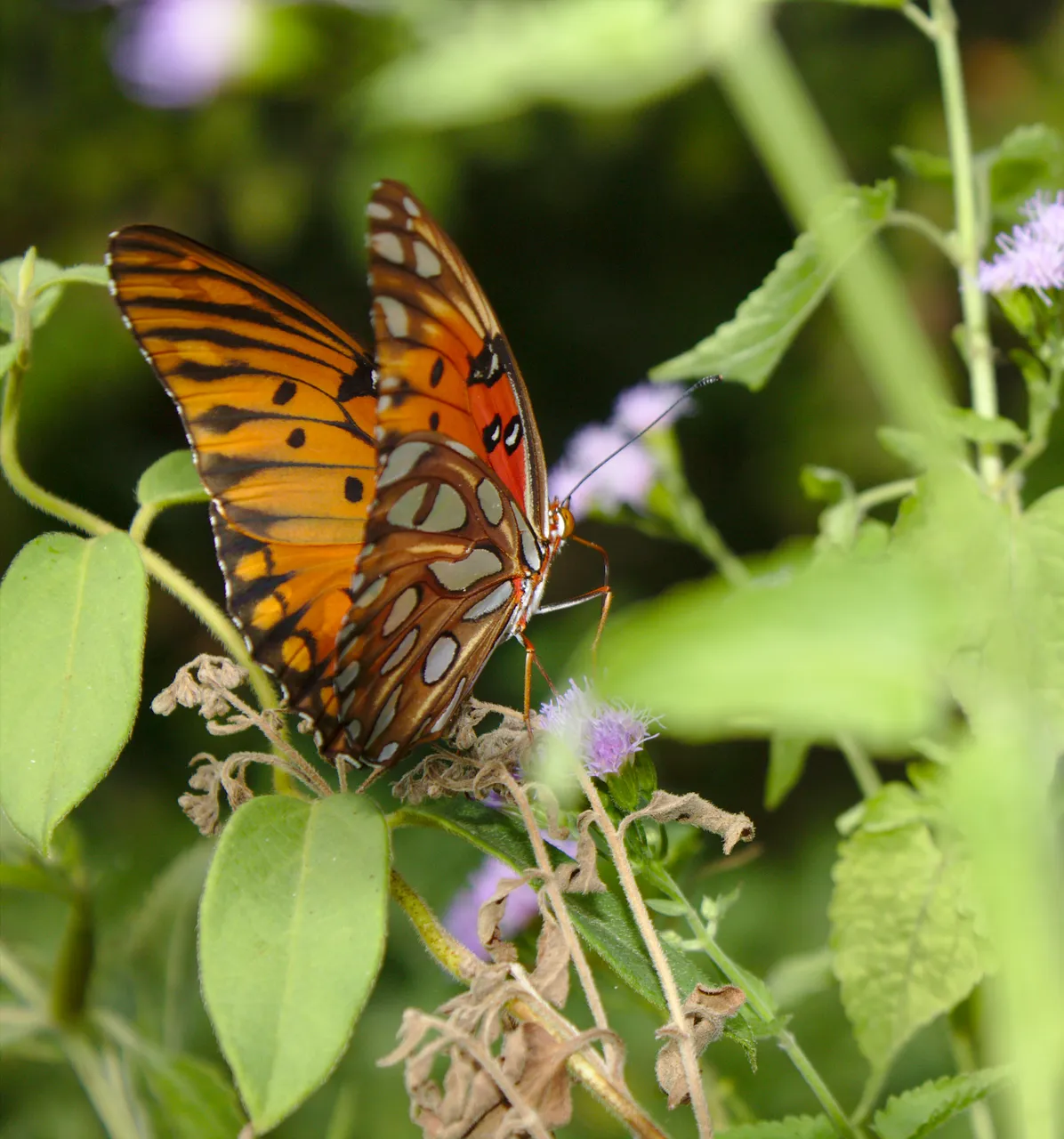I have mentioned several times lately that I was growing frustrated with trying to take good photos of butterflies. They just never seem to let me get close enough for me to capture any detail. But, it never fails with me; when I say things like that, something happens to make me out a liar. Case in point…
This Beautiful Butterfly

As I was out for my lunchtime stroll, another orange butterfly caught my eye. Its flight reminded me of the Reading Rainbow intro from when I was a kid. It’s probably a good thing that no one else was around to hear me.
A Monarch? Another Viceroy? What Is It?
When I first saw this beautiful butterfly, I automatically assumed it was either another viceroy or perhaps the elusive Monarch. I needed a closer look to see if it had that extra little line across the lower wing that is indicative of the viceroy. But, this butterfly allowed me to get really close. As I got nearer, I realized that this was neither a monarch nor a viceroy! Its wings were deep fiery orange, and there were white dots with dark black outlines. Then, they folded, and it was like I was looking at a completely different butterfly. The underside of the forewing still had some of that fiery orange with white spots, but there were three silvery blue splotches toward the apex of the wing that were surrounded by black. The underside of the hindwing was all black with those same silvery blue splotches. It was one of the most beautiful butterflies that I had ever seen, which admittedly isn’t saying much, since it has only been recently that I have made the attempt to get close enough to them to see these types of details.
The Beauty Hidden Underneath

Gulf Fritillary - The Gulf Fritillary (Agraulis vanillae)

I did an internet search for “orange butterfly blue spots under wing”, and I had to search through a couple of pages of images; but I eventually found a match and learned that this was a gulf fritillary. As usual, I set out to make a quick, simple photography post, but I got all caught up in reading and couldn’t resist sharing some cool things about this butterfly.
So, Here We Go!
The Gulf Fritillary is native to the southern half of the US and a large portion of Mexico; all areas that surround the Gulf of Mexico. The adult butterfly feeds on the nectar of Lantana, Butterfly Bush, Zinnia, Aster, Thistle, and Verbena, among others. I find it interesting that the predominant color of all of the flowers is purple. I have noticed a trend in my research of the various butterflies and other insects I have written about where they tend to gravitate toward or sometimes avoid certain colors. Sure enough, the flowers that this specimen were feeding from were purple, though I’m not sure what kind they were.
Sippin’ On Some Sizzurp

What About The Children?
Caterpillars of the species feed on leaves of the passion vine. @pappa-pepper recently posted an article about the passion vine, its utterly gorgeous flowers, and the tasty fruit that they yield. If you haven’t read it, you should definitely check it out! Similar to the monarch and viceroy, the fritillary’s diet of passion vine leaves imbues it with a toxic effect that lasts through adulthood. If that isn’t enough to deter would-be predators, the adults butterfly has the ability to release a stinky chemical concoction from glands on its abdomen. However, if you plan on planting passion vines with the intention of attracting this beautiful species, be careful and do your research. Some species of the plant are not edible and may even be toxic for the caterpillars.
The caterpillars are beautiful in their own right. I’ve never seen one, so I don’t have a photo of my own; however, you can see what the look like on other sites. They are mostly orange, often times having green to black stripes running the length of their body, although there are variants found in Texas that are mostly lavender and have orange colored stripes, instead. They also have sharp, black spines covering their body, making them a beauty to behold but not to be held.
In Conclusion
This was one of the most awe inspiring photo shoots that I have attempted. I feel truly blessed to have had the opportunity to get so close to such a beautiful creature, especially seeing as how they can be elusive and don’t spend a lot of time at ground level. I’ve been interested in growing passion vine for a while, but mostly to try the fruit. Now that I have seen the beauty that they can attract, I think passion vine will be the first thing that I plant whenever we finally find our place out in the country and get settled in. * All photos taken by me using Canon Rebel T3; Lens Model: EF-S18-55mm f/3.5-5.6 IS II. Macro shots were taken using a cheap screw on macro adapter; post processing performed using Darktable unless otherwise labeled.
Thanks for reading today’s article! If you enjoyed it, maybe you would like to check out some of my other recent content:
**Wonder why I kept referencing monarchs and viceroys in today's article? Read my previous post where I talk about them.
**Find out a little bit about the majestic luna moth.
Take a look at the small stagshorn fungus.
Learn about the silver spotted skipper and its creep looking caterpillar.
Read my rant about the confusion between venomous and poisonous organisms that I entered into @suesa’s Science Challenge #2
